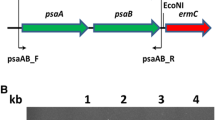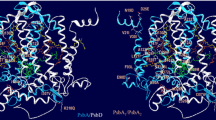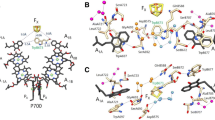Abstract
Despite the high level of symmetry between the PsaA and PsaB polypeptides in Photosystem I, some amino acids pairs are strikingly different, such as PsaA-Gly693 and PsaB-Trp673, which are located near a cluster of 11 water molecules between the A1A and A1B quinones and the FX iron-sulfur cluster. In this work, we changed PsaB-Trp673 to PsaB-Phe673 in Synechocystis sp. PCC 6803. The variant contains ~ 85% of wild-type (WT) levels of Photosystem I but is unable to grow photoautotrophically. Both time-resolved and steady-state optical measurements show that in the PsaB-W673F variant less than 50% of the electrons reach the terminal iron-sulfur clusters FA and FB; the majority of the electrons recombine from A1A− and A1B−. However, in those reaction centers which pass electrons forward the transfer is heterogeneous: a minor population shows electron transfer rates from A1A− and A1B− to FX slightly slower than that of the WT, whereas a major population shows forward electron transfer rates to FX slowed to the ~ 10 µs time range. Competition between relatively similar forward and backward rates of electron transfer from the quinones to the FX cluster account for the relatively low yield of long-lived charge separation in the PsaB-W673F variant. A higher water content and its increased mobility observed in MD simulations in the interquinone cavity of the PsaB-W673F variant shifts the pK of PsaB-Asp575 and allows its deprotonation in situ. The heterogeneity found may be rooted in protonation state of PsaB-Asp575, which controls whether electron transfer can proceed beyond the phylloquinone cofactors.








Similar content being viewed by others
References
Abraham MJ, Murtola T, Schulz R et al (2015) Gromacs: High performance molecular simulations through multi-level parallelism from laptops to supercomputers. SoftwareX 1–2:19–25. https://doi.org/10.1016/j.softx.2015.06.001
Agalarov R, Brettel K (2003) Temperature dependence of biphasic forward electron transfer from the phylloquinone(s) A1 in photosystem I: only the slower phase is activated. Biochim Biophys Acta Bioenerg 1604:7–12. https://doi.org/10.1016/S0005-2728(03)00024-0
Agarwala R, Barrett T, Beck J et al (2018) Database resources of the National Center for Biotechnology Information. Nucleic Acids Res 46:D8–D13. https://doi.org/10.1093/nar/gkx1095
Agarwala N, Makita H, Luo L et al (2020) Reversible inhibition and reactivation of electron transfer in photosystem I. Photosynth Res 145:97–109. https://doi.org/10.1007/s11120-020-00760-9
Ali K, Santabarbara S, Heathcote P et al (2006) Bidirectional electron transfer in photosystem I: replacement of the symmetry-breaking tryptophan close to the PsaB-bound phylloquinone (A1B) with a glycine residue alters the redox properties of A1B and blocks forward electron transfer at cryogenic tempe. Biochim Biophys Acta Bioenerg 1757:1623–1633. https://doi.org/10.1016/j.bbabio.2006.07.006
Andersen B, Scheller HV, Møller BL (1992) The PSI-E subunit of photosystem I binds ferredoxin:NADP+ oxidoreductase. FEBS Lett 311:169–173. https://doi.org/10.1016/0014-5793(92)81391-X
Andersson PO, Gillbro T, Ferguson L, Cogdell RJ (1991) Absorption spectral shifts of carotenoids related to medium polarizability. Photochem Photobiol 54:353–360. https://doi.org/10.1111/j.1751-1097.1991.tb02027.x
Baugher J, Hindman JC, Katz JJ (1979) Determination of the triplet and excited singlet absorption spectra of chlorophyll a with a tunable dye laser. Chem Phys Lett 63:159–162. https://doi.org/10.1016/0009-2614(79)80480-7
Bell RP, Bell RP (1973) The direct study of rates of simple proton-transfer reactions. The proton in chemistry. Springer, New York, pp 111–132
Brettel K (1988) Electron transfer from A1– to an iron-sulfur center with t1/2 = 200 ns at room temperature in photosystem I Characterization by flash absorption spectroscopy. FEBS Lett 239:93–98. https://doi.org/10.1016/0014-5793(88)80552-0
Brettel K (1997) Electron transfer and arrangement of the redox cofactors in photosystem I. Biochim Biophys Acta Bioenerg 1318:322–373
Brettel K, Leibl W (2001) Electron transfer in photosystem I. Biochim Biophys Acta Bioenerg 1507:100–114
Byrdin M, Santabarbara S, Gu F et al (2006) Assignment of a kinetic component to electron transfer between iron-sulfur clusters FX and FA/B of Photosystem I. Biochim Biophys Acta Bioenerg 1757:1529–1538. https://doi.org/10.1016/j.bbabio.2006.06.016
Chamorovsky SK, Cammack R (1982) Direct determination of the midpoint potential of the acceptor X in chloroplast photosystem by electrochemical reduction and ESR spectroscopy. Photobiochem Photobiophys 4:195–200
Chang CH, Kim K (2009) Density functional theory calculation of bonding and charge parameters for molecular dynamics studies on [FeFe] hydrogenases. J Chem Theory Comput 5:1137–1145. https://doi.org/10.1021/ct800342w
Cherepanov DA, Milanovsky GE, Gopta OA et al (2018) Electron-phonon coupling in cyanobacterial photosystem I. J Phys Chem B 122:7943–7955. https://doi.org/10.1021/acs.jpcb.8b03906
Cohen RO, Shen G, Golbeck JH et al (2004) Evidence for asymmetric electron transfer in cyanobacterial photosystem I: analysis of a methionine-to-leucine mutation of the ligand to the primary electron acceptor A0. Biochemistry 43:4741–4754. https://doi.org/10.1021/bi035633f
Duan Y, Wu C, Chowdhury S et al (2003) A point-charge force field for molecular mechanics simulations of proteins based on condensed-phase quantum mechanical calculations. J Comput Chem 24:1999–2012. https://doi.org/10.1002/jcc.10349
Golbeck J, Bryant D (1991) Photosystem I. Current topics in bioenergetics. Academic Press, INC, New York, pp 83–177
Gopta OA, Cherepanov DA, Junge W, Mulkidjanian AY (1999) Proton transfer from the bulk to the bound ubiquinone QB of the reaction center in chromatophores of Rhodobacter sphaeroides: retarded conveyance by neutral water. Proc Natl Acad Sci USA 96:13159–13164. https://doi.org/10.1073/pnas.96.23.13159
Guergova-Kuras M, Boudreaux B, Joliot A et al (2001) Evidence for two active branches for electron transfer in photosystem I. Proc Natl Acad Sci USA 98:4437–4442. https://doi.org/10.1073/pnas.081078898
Guex N, Peitsch MC (1997) SWISS-MODEL and the Swiss-PdbViewer: an environment for comparative protein modeling. Electrophoresis 18:2714–2723. https://doi.org/10.1002/elps.1150181505
Humphrey W, Dalke A, Schulten K (1996) VMD: Visual molecular dynamics. J Mol Gr 14:33–38. https://doi.org/10.1016/0263-7855(96)00018-5
Ishikita H, Knapp EW (2003) Redox potential of quinones in both electron transfer branches of Photosystem I. J Biol Chem 278:52002–52011. https://doi.org/10.1074/jbc.M306434200
Ivashin N, Larsson S (2003) Electron transfer pathways in photosystem I reaction centers. Chem Phys Lett 375:383–387. https://doi.org/10.1016/S0009-2614(03)00855-8
Joliot P, Joliot A (1999) In vivo analysis of the electron transfer within photosystem I: are the two phylloquinones involved. Biochemistry 38:11130–11136. https://doi.org/10.1021/bi990857c
Jordan P, Fromme P, Witt HT et al (2001) Three-dimensional structure of cyanobacterial photosystem I at 2.5 Å resolution. Nature 411:909–917. https://doi.org/10.1038/35082000
Kawashima K, Ishikita H (2017) Structural factors that alter the redox potential of quinones in cyanobacterial and plant Photosystem I. Biochemistry 56:3019–3028. https://doi.org/10.1021/acs.biochem.7b00082
Koyama Y, Fujii R (2006) Cis-trans carotenoids in photosynthesis: configurations, excited-state properties and physiological functions. The photochemistry of carotenoids. Kluwer Academic Publishers, Dordrecht, pp 161–188
Kurashov V, Gorka M, Milanovsky GE et al (2018) Critical evaluation of electron transfer kinetics in P700–FA/FB, P700–FX, and P700–A1 Photosystem I core complexes in liquid and in trehalose glass. Biochim Biophys Acta Bioenerg 1859:1288–1301. https://doi.org/10.1016/j.bbabio.2018.09.367
Leibl W, Toupance B, Breton J (1995) Photoelectric characterization of forward electron transfer to iron-sulfur centers in Photosystem I. Biochemistry 34:10237–10244. https://doi.org/10.1021/bi00032a018
Lichtenthaler HK (1987) Chlorophylls and carotenoids: pigments of photosynthetic biomembranes. Methods Enzymol 148:350–382. https://doi.org/10.1016/0076-6879(87)48036-1
Makita H, Hastings G (2015) Directionality of electron transfer in cyanobacterial photosystem i at 298 and 77 K. FEBS Lett 589:1412–1417. https://doi.org/10.1016/j.febslet.2015.04.048
Malavath T, Caspy I, Netzer-El SY et al (2018) Structure and function of wild-type and subunit-depleted photosystem I in Synechocystis. Biochim Biophys Acta Bioenerg 1859:645–654. https://doi.org/10.1016/j.bbabio.2018.02.002
Mathis P, Sétif P (1988) Kinetic studies on the function of A1 in the photosystem I reaction center. FEBS Lett 237:65–68. https://doi.org/10.1016/0014-5793(88)80173-X
Milanovsky GE, Petrova AA, Cherepanov DA, Semenov AY (2017) Kinetic modeling of electron transfer reactions in photosystem I complexes of various structures with substituted quinone acceptors. Photosynth Res 133:185–199. https://doi.org/10.1007/s11120-017-0366-y
Milanovsky G, Gopta O, Petrova A et al (2019) Multiple pathways of charge recombination revealed by the temperature dependence of electron transfer kinetics in cyanobacterial photosystem I. Biochim Biophys Acta Bioenerg 1860:601–610. https://doi.org/10.1016/j.bbabio.2019.06.008
Nelson N, Junge W (2015) Structure and energy transfer in photosystems of oxygenic photosynthesis. Annu Rev Biochem 84:659–683. https://doi.org/10.1146/annurev-biochem-092914-041942
Parrett KG, Mehari T, Warren PG, Golbeck JH (1989) Purification and properties of the intact P-700 and FX-containing Photosystem I core protein. BBA Bioenerg 973:324–332. https://doi.org/10.1016/S0005-2728(89)80439-6
Ptushenko VV, Cherepanov DA, Krishtalik LI, Semenov AY (2008) Semi-continuum electrostatic calculations of redox potentials in photosystem I. Photosynth Res 97:55–74. https://doi.org/10.1007/s11120-008-9309-y
Ramesh VM, Gibasiewicz K, Lin S et al (2004) Bidirectional electron transfer in Photosystem I: accumulation of A0– in A-side or B-side mutants of the axial ligand to chlorophyll A0. Biochemistry 43:1369–1375. https://doi.org/10.1021/bi0354177
Santabarbara S, Heathcote P, Evans MCW (2005a) Modelling of the electron transfer reactions in Photosystem I by electron tunnelling theory: the phylloquinones bound to the PsaA and the PsaB reaction centre subunits of PS I are almost isoenergetic to the iron-sulfur cluster FX. Biochim Biophys Acta Bioenerg 1708:283–310
Santabarbara S, Kuprov I, Fairclough WV et al (2005b) Bidirectional electron transfer in photosystem I: determination of two distances between P700+ and A1– in spin-correlated radical pairs. Biochemistry 44:2119–2128. https://doi.org/10.1021/bi048445d
Santabarbara S, Reifschneider K, Jasaitis A et al (2010) Interquinone electron transfer in photosystem I as evidenced by altering the hydrogen bond strength to the phylloquinone(s). J Phys Chem B 114:9300–9312. https://doi.org/10.1021/jp1038656
Savikhin S, Xu W, Chitnis PR, Struve WS (2000) Ultrafast primary processes in PS I from Synechocystis sp. PCC 6803: Roles of P700 and A0. Biophys J 79:1573–1586. https://doi.org/10.1016/S0006-3495(00)76408-3
Savikhin S, Xu W, Martinsson P et al (2001) Kinetics of charge separation and A0– → A1 electron transfer in photosystem I reaction centers. Biochemistry 40:9282–9290. https://doi.org/10.1021/bi0104165
Schlodder E, Falkenberg K, Gergeleit M, Brettel K (1998) Temperature dependence of forward and reverse electron transfer from A1–, the reduced secondary electron acceptor in photosystem I. Biochemistry 37:9466–9476. https://doi.org/10.1021/bi973182r
Sétif P (2001) Ferredoxin and flavodoxin reduction by photosystem I. Biochim Biophys Acta Bioenerg 1507:161–179
Sétif P, Brettel K (1993) Forward electron transfer from phylloquinone A1 to iron-sulfur centers in spinach Photosystem I. Biochemistry. https://doi.org/10.1021/bi00082a002
Sétif P, Bottin H, Mathis P (1985) Absorption studies of primary reactions in Photosystem I. Yield and rate of formation of the P-700 triplet state. BBA Bioenerg 808:112–122. https://doi.org/10.1016/0005-2728(85)90033-7
Shen G, Bryant DA (1995) Characterization of a Synechococcus sp. strain PCC 7002 mutant lacking Photosystem I. Protein assembly and energy distribution in the absence of the Photosystem I reaction center core complex. Photosynth Res 44:41–53. https://doi.org/10.1007/BF00018295
Shen G, Boussiba S, Vermaas WF (1993) Synechocystis sp. PCC 6803 strains lacking photosystem I and phycobilisome function. Plant Cell 5:1853–1863
Shinkarev VP, Vassiliev IR, Golbeck JH (2000) A kinetic assessment of the sequence of electron transfer from FX to FA and further to FB in photosystem I: the value of the equilibrium constant between FX and FA. Biophys J 78:363–372. https://doi.org/10.1016/S0006-3495(00)76599-4
Shinkarev VP, Zybailov B, Vassiliev IR, Golbeck JH (2002) Modeling of the P700+ charge recombination kinetics with phylloquinone and plastoquinone-9 in the A1 site of photosystem I. Biophys J 83:2885–2897. https://doi.org/10.1016/S0006-3495(02)75298-3
Soukoulis V, Savikhin S, Xu W et al (1999) Electronic spectra of PS I mutants: the peripheral subunits do not bind red chlorophylls in Synechocystis sp. PCC 6803. Biophys J 76:2711–2715. https://doi.org/10.1016/S0006-3495(99)77423-0
Srinivasan N, Santabarbara S, Rappaport F et al (2011) Alteration of the H-Bond to the A1A phylloquinone in photosystem I: influence on the kinetics and energetics of electron transfer. J Phys Chem B 115:1751–1759. https://doi.org/10.1021/jp109531b
Sun J, Xu W, Hervás M et al (1999) Oxidizing side of the cyanobacterial photosystem I. Evidence for interaction between the electron donor proteins and a luminal surface helix of the PsaB subunit. J Biol Chem 274:19048–19054. https://doi.org/10.1074/jbc.274.27.19048
Sun J, Hao S, Radle M et al (2014) Evidence that histidine forms a coordination bond to the A0A and A0B chlorophylls and a second H-bond to the A1A and A1B phylloquinones in M688HPsaA and M668HPsaB variants of Synechocystis sp. PCC 6803. Biochim Biophys Acta Bioenerg 1837:1362–1375. https://doi.org/10.1016/j.bbabio.2014.04.004
Vassiliev IR, Jung YS, Smart LB et al (1995) A mixed-ligand iron-sulfur cluster (C556SPsaB or C565SPsaB) in the Fx-binding site leads to a decreased quantum efficiency of electron transfer in photosystem I. Biophys J 69:1544–1553. https://doi.org/10.1016/S0006-3495(95)80026-3
Vassiliev IR, Jung YS, Mamedov MD et al (1997) Near-IR absorbance changes and electrogenic reactions in the microsecond-to-second time domain in photosystem I. Biophys J 72:301–315. https://doi.org/10.1016/S0006-3495(97)78669-7
Xu W, Chitnis P, Valieva A et al (2003a) Electron transfer in cyanobacterial photosystem I. I. Physiological and spectroscopic characterization of site-directed mutants in a putative electron transfer pathway from A0 through A1 to FX. J Biol Chem 278:27864–27875. https://doi.org/10.1074/jbc.M302962200
Xu W, Chitnis PR, Valieva A et al (2003b) Electron transfer in cyanobacterial Photosystem I. II. Determination of forward electron transfer rates of site-directed mutants in a putative electron transfer pathway from A0 through A1 to FX. J Biol Chem 278:27876–27887. https://doi.org/10.1074/jbc.M302965200
Xu W, Wang Y, Taylor E et al (2011) Mutational analysis of photosystem I of Synechocystis sp. PCC 6803: The role of four conserved aromatic residues in the j-helix of PsaB. PLoS ONE 6:e24625. https://doi.org/10.1371/journal.pone.0024625
Zhang L, Silva DA, Yan Y, Huang X (2012) Force field development for cofactors in the photosystem II. J Comput Chem 33:1969–1980. https://doi.org/10.1002/jcc.23016
Acknowledgements
The molecular biology was supported by grants from NSF EPSCoR (NSF(2010)-PFUND-217), the Louisiana RCS and Enhancement Program (LEQSF(2013-16)-RD-A-15), (LEQSF(2014-15)-ENH-TR-28) and (LEQSF(2015-16)-ENH-TR-34) to W.X. The time-resolved optical studies were supported by NSF Grant MCB-1613022 to J.H.G. The (P700+ − P700) measurements were supported by DOE grant DE-SC0018239 to S.S. The theoretical calculations were supported by the Russian Science Foundation Grant RSF 19-14-00366 to D.C. and A.S. A.S. and G.M. acknowledge partial support from Lomonosov Moscow State University Program of Development. The authors thank Andrei Y. Chistoserdov from the Department of Biology at University of Louisiana at Lafayette for his help and support on this project. An undergraduate student, Lillian D. Lestelle, cultured cells and isolated plasmid DNAs.
Author information
Authors and Affiliations
Corresponding authors
Ethics declarations
Conflict of interest
The authors declare no conflict of interest.
Additional information
Publisher's Note
Springer Nature remains neutral with regard to jurisdictional claims in published maps and institutional affiliations.
Supplementary Information
Below is the link to the electronic supplementary material.
Rights and permissions
About this article
Cite this article
Kurashov, V., Milanovsky, G., Luo, L. et al. Conserved residue PsaB-Trp673 is essential for high-efficiency electron transfer between the phylloquinones and the iron-sulfur clusters in Photosystem I. Photosynth Res 148, 161–180 (2021). https://doi.org/10.1007/s11120-021-00839-x
Received:
Accepted:
Published:
Issue Date:
DOI: https://doi.org/10.1007/s11120-021-00839-x




